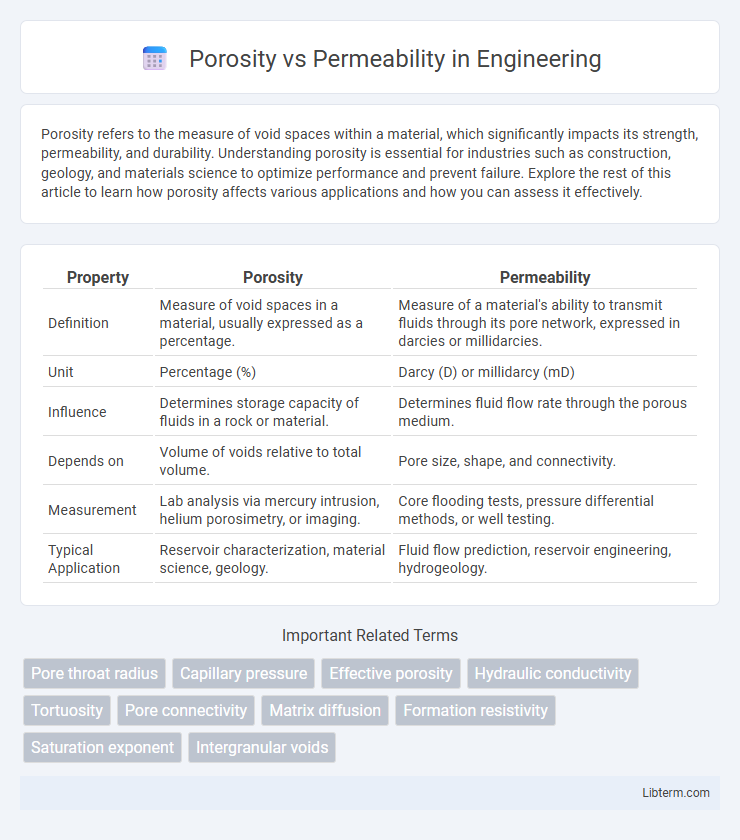Porosity refers to the measure of void spaces within a material, which significantly impacts its strength, permeability, and durability. Understanding porosity is essential for industries such as construction, geology, and materials science to optimize performance and prevent failure. Explore the rest of this article to learn how porosity affects various applications and how you can assess it effectively.
Table of Comparison
| Property | Porosity | Permeability |
|---|---|---|
| Definition | Measure of void spaces in a material, usually expressed as a percentage. | Measure of a material's ability to transmit fluids through its pore network, expressed in darcies or millidarcies. |
| Unit | Percentage (%) | Darcy (D) or millidarcy (mD) |
| Influence | Determines storage capacity of fluids in a rock or material. | Determines fluid flow rate through the porous medium. |
| Depends on | Volume of voids relative to total volume. | Pore size, shape, and connectivity. |
| Measurement | Lab analysis via mercury intrusion, helium porosimetry, or imaging. | Core flooding tests, pressure differential methods, or well testing. |
| Typical Application | Reservoir characterization, material science, geology. | Fluid flow prediction, reservoir engineering, hydrogeology. |
Introduction to Porosity and Permeability
Porosity measures the percentage of void spaces within a rock or soil that can store fluids, influencing its capacity to hold water, oil, or gas. Permeability refers to the ability of those fluids to flow through interconnected pore spaces, determining the ease of fluid movement within the material. Understanding both porosity and permeability is essential in fields like hydrogeology, petroleum engineering, and soil science for evaluating reservoir quality and fluid dynamics.
Defining Porosity in Geological Materials
Porosity in geological materials refers to the percentage of void spaces or pores within a rock or sediment volume, which determines its capacity to hold fluids such as water, oil, or gas. This property quantifies the storage potential but does not indicate the ease of fluid flow, which is governed by permeability. Effective porosity excludes isolated pores, focusing only on interconnected pores that contribute to fluid storage and movement within geological formations.
Understanding Permeability and Its Importance
Permeability measures a material's ability to transmit fluids through interconnected pore spaces, which directly influences fluid flow in reservoirs and aquifers. High permeability indicates efficient fluid movement, crucial for optimizing oil recovery, groundwater extraction, and environmental remediation. While porosity quantifies the total pore volume, permeability determines the ease of fluid passage, making it essential for predicting subsurface fluid dynamics and designing extraction strategies.
Key Differences Between Porosity and Permeability
Porosity refers to the percentage of void spaces or pores within a material, indicating its capacity to hold fluids, whereas permeability measures the ability of those fluids to flow through the interconnected pore network. High porosity does not guarantee high permeability, as pore connectivity and size critically influence fluid movement. In reservoir engineering, understanding both properties is essential for evaluating rock formations and predicting fluid extraction efficiency.
Factors Affecting Porosity in Rocks and Soils
Porosity in rocks and soils is influenced primarily by grain size, sorting, and compaction, where well-sorted, coarse-grained sediments typically exhibit higher porosity due to larger and more numerous pore spaces. Cementation and mineral composition further affect porosity by filling voids and altering pore structure, which decreases the overall pore volume available for fluid storage. Bioturbation and fracturing can enhance porosity by creating additional voids, impacting the rock or soil's capacity to retain and transmit fluids.
Factors Influencing Permeability in Subsurface Materials
Permeability in subsurface materials is primarily controlled by the size, shape, and connectivity of pore spaces, which influence fluid flow rates through rocks or soil. Grain size distribution and sorting significantly affect permeability, as well-sorted materials with larger, well-connected pores allow higher permeability compared to poorly sorted or compacted sediments. Additionally, the presence of fractures and the degree of cementation alter permeability by either providing flow pathways or obstructing pore connectivity.
Relationship Between Porosity and Permeability
Porosity measures the percentage of void spaces in a material, while permeability quantifies the ability of fluids to flow through those voids. High porosity does not always guarantee high permeability because the connectivity and size of the pores significantly influence fluid movement. The relationship between porosity and permeability is complex and depends on factors like pore geometry, distribution, and the presence of fractures or sediment compaction.
Measurement Techniques for Porosity and Permeability
Porosity measurement techniques include gas pycnometry, mercury intrusion porosimetry, and nuclear magnetic resonance (NMR) to quantify the void fraction within a material accurately. Permeability is commonly evaluated using steady-state and transient flow methods, such as the Darcy's law-based permeameter and pulse-decay tests, to determine fluid flow capacity through porous media. Advanced imaging techniques like micro-CT scanning support both porosity and permeability assessments by providing detailed pore structure visualization and connectivity data.
Applications in Hydrogeology, Petroleum, and Engineering
Porosity determines the storage capacity of rocks and sediments by measuring the volume of void spaces, while permeability indicates the ease with which fluids flow through these interconnected pores. In hydrogeology, high porosity and permeability are critical for aquifer productivity and groundwater movement, ensuring efficient water extraction and recharge. Petroleum engineering relies on these properties to evaluate reservoir quality, affecting oil and gas recovery rates, whereas civil engineering considers porosity and permeability for soil stability, drainage design, and contaminant transport control.
Summary: Choosing Between Porosity and Permeability in Practice
Porosity measures the volume percentage of void spaces in a material, essential for determining storage capacity, while permeability quantifies the ability of fluids to flow through these voids, critical for fluid transmission. In practice, selecting between porosity and permeability depends on the application: reservoir engineers prioritize permeability for oil extraction efficiency, whereas geologists may emphasize porosity for assessing groundwater storage potential. Accurate evaluation of both parameters ensures optimal decision-making in hydrogeology, petroleum engineering, and environmental studies.
Porosity Infographic

 libterm.com
libterm.com